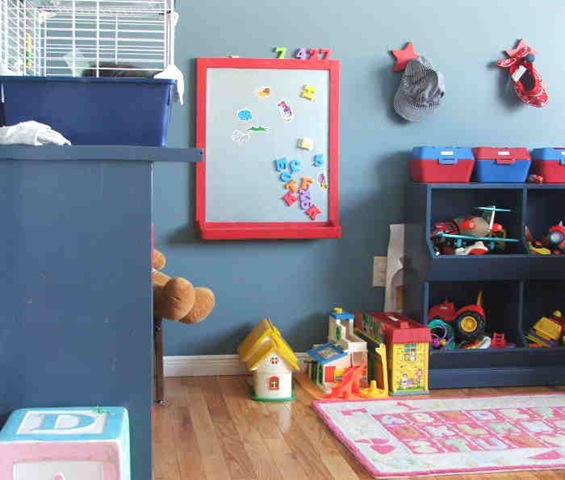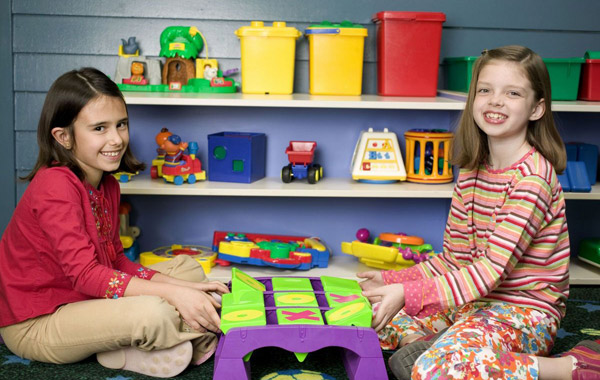When I had 5 children, those that were of school age went to public school. I didn’t know anything about home schooling and in fact had never really heard about it. However, I had created for my children, what amounted to a huge Spark Station. We had a large basement room. In that room there were shelves containing many different toys and items of interest. Everything was in a bag or a box and was neatly labeled so that you could always find what you were looking for. There was also a cupboard with paper, scissors, glue, tape etc. This was a fabulous place for my children to play. As my oldest daughter Jodie said, “It was magical.”
You might think that I was just so organized and that this was the perfect thing. Don’t believe it. It was a magical place sometimes but it had the same problems that many of you face who have tried to implement the Spark Station as a schooling tool. First, it was open at any time. My children would go down and play for a few days and then it would lose its allure because it was old hat and it was a mess. They would not go down there to play no matter what and just wanted to hang around me doing whatever I was trying to do or would want to park in front of the TV. That was maddening for me because I had provided them a wonderful place filled with amazing delights and they just wanted to pester me. I couldn’t figure that out.
Secondly, it would become a nightmare to clean up. There were two factors which caused this to happen. First I wasn’t present either physically or mentally when the room was being used and second, when they were tiring of the room and it contents they would just get things out and scatter them around until they had run through everything and the place was chaos. Then it would be abandoned until I got tired of them and the mess and put it to rights again.
So let’s look at what would have made this room work the way I wanted it to and would have had even more benefit and fascination for my children. I realize now that it would have been a really good idea to pick a space of time every day that was “playroom time.” That would have been a time for me to be with my children, to participate with them if I was needed or to pursue some reading of my own if they were managing themselves. I would be learning and they would be doing the same.
If I was there I could have helped them clean up one mess before creating another. I would have been able to monitor the glue, scissors, tinker toys, Lego’s, etc. I would have been there to read a book to a younger child or to help an older child fix a slide for the microscope. This would have helped to maintain order, keep myself from having a room of total chaos to clean every week and build stronger bonds between myself and my children.
If the room were only available to them for certain periods of time its fascination would not have faded and they would not have fallen into the trap of “mess-creating” in an effort to make it be something new. I know that is an odd sentence but all you mothers out there will probably clearly understand its meaning.
I have an 18 month old grandson who is able to visit at our home either once a week or every two weeks. We love having him and his sister. In the hallway is a built in cupboard with a few drawers and shelves. Within 5 minutes of coming he heads straight for the drawer and wants someone to open it for him. He knows that it is his special drawer and is filled with “new” toys. These toys rarely change yet he is fascinated with the contents of the drawer. The principle at work here is that it isn’t readily available to him whenever he wants it, only when he comes to grandma’s house.
I have three granddaughters who live about eight hours away. When they come they stay 5-7 days. They also head for the drawer and the cupboard. Out come the crayons, glue tape etc. They are so fascinated with all these things and spend great amounts of time creating. If they are allowed to just use the cupboard anytime they want, by day 5 or so things are beginning to lose their appeal and they are making messes. Color books are everywhere, glue lids are off etc. The cupboard loses its excitement and we reach the “creating a mess is something new” stage.
Management of this tool is important because we want to keep it working until all of our children have entered the scholar phase. And then if we are really wise we will want to keep it going for our grandchildren. If it is always a mess, the kids aren’t interested or we begin to feel overwhelmed, then the whole system falls apart and we quit using it. So let’s recap the important elements of good “Spark Station” management.
1. Schedule time and be consistent. Your children will really look forward to the time that they can use the Spark Station and be with you. They will be excited to see what is new and revisit what they liked from the day before. They will really be excited with your consistency. They will appreciate being able to count on it.
2. Be present. Be with your children both mentally and physically when they are using the Spark Station. You are there to help when they ask, bond and prevent chaos. This is not the time to get your children “busy” and then go off to have some alone time. This will go along way to preventing “creating a mess is something new”.
3. Keep it simple. Rotate the contents. Do this a little at a time. Think about which items haven’t seen the light of day for a few weeks or months and replace them with something else. If there is an activity or toy that is causing a mess and you can’t stand it replace it until you can stand it again. (Tubs of colored rice are a good example. Kids LOVE this activity but it is messy no matter how careful they are.) Don’t overload your Spark Station.
4. Keep it special. NEVER fudge on this. If your children want into the Spark Station on Saturday or Sunday or other “non structured family learning” times, help them choose a quiet activity while you take a moment to read to them. You could also engage them in what you are doing or help them find another activity. When they want in the Spark Station at “non structured family learning” times, what they are saying is “I am bored” or “I want time with you”.
5. Plan ahead so that you can have what you need on hand, be present and enjoy being with your children.
Remember that everything is an experiment. Have fun, make changes, be flexible and roll with the punches. Your children will love you for it!
Possibly Related Posts:
- 5 Creative Writing Exercises for Kids of All Ages
- 5 Ways to Help Your Child Think Like a Scientist
- Make it Special – Chores and Family Work
- What Does it mean to have Our Ducks in a Row
- A Question about the Spark Station from a Reader









{ 0 comments… add one now }